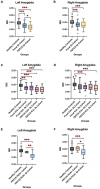This is a preprint.
Altered Amygdala Volumes and Microstructure in Focal Epilepsy Patients with Tonic-Clonic Seizures, Ictal and Post-Ictal Central Apnea
- PMID: 36993530
- PMCID: PMC10055587
- DOI: 10.1101/2023.03.16.23287369
Altered Amygdala Volumes and Microstructure in Focal Epilepsy Patients with Tonic-Clonic Seizures, Ictal and Post-Ictal Central Apnea
Update in
-
Altered amygdala volumes and microstructure in focal epilepsy patients with tonic-clonic seizures, ictal, and post-convulsive central apnea.Epilepsia. 2023 Dec;64(12):3307-3318. doi: 10.1111/epi.17804. Epub 2023 Oct 31. Epilepsia. 2023. PMID: 37857465 Free PMC article.
Abstract
Objectives: Sudden unexpected death in epilepsy (SUDEP) is a leading cause of death for patients with epilepsy; however, the pathophysiology remains unclear. Focal-to-bilateral tonic-clonic seizures (FBTCS) are a major risk factor, and centrally-mediated respiratory depression may increase the risk further. Here, we determined volume and microstructure of the amygdala, a key structure that can trigger apnea in people with focal epilepsy, stratified by presence or absence of FBTCS, ictal central apnea (ICA) and post-ictal central apnea (PICA).
Methods: 73 patients with only-focal seizures and 30 with FBTCS recorded during video EEG (VEEG) with respiratory monitoring were recruited prospectively during presurgical investigations. We acquired high-resolution T1-weighted anatomical and multi-shell diffusion images, and computed neurite orientation dispersion and density imaging (NODDI) metrics in all epilepsy patients and 69 healthy controls. Amygdala volumetric and microstructure alterations were compared between healthy subjects, and patients with only-focal seizures or FBTCS The FBTCS group was further subdivided by presence of ICA and PICA, verified by VEEG.
Results: Bilateral amygdala volumes were significantly increased in the FBTCS cohort compared to healthy controls and the focal cohort. Patients with recorded PICA had the highest increase in bilateral amygdala volume of the FBTCS cohort.Amygdala neurite density index (NDI) values were significantly decreased in both the focal and FBTCS groups relative to healthy controls, with values in the FBTCS group being the lowest of the two. The presence of PICA was associated with significantly lower NDI values vs the non-apnea FBTCS group (p=0.004).
Significance: Individuals with FBTCS and PICA show significantly increased amygdala volumes and disrupted architecture bilaterally, with greater changes on the left side. The structural alterations reflected by NODDI and volume differences may be associated with inappropriate cardiorespiratory patterns mediated by the amygdala, particularly after FBTCS. Determination of amygdala volumetric and architectural changes may assist identification of individuals at risk.
Keywords: NODDI; SUDEP; amygdala; apnea; diffusion MRI; tonic-clonic seizures.
Conflict of interest statement
Disclosure of Conflicts of Interest None of the authors has any conflict of interest to disclose. We confirm that we have read the Journal's position on issues involved in ethical publication and affirm that this report is consistent with those guidelines.
Figures


References
-
- Surges R, Thijs RD, Tan HL, Sander JW. Sudden unexpected death in epilepsy: risk factors and potential pathomechanisms. Nat Rev Neurol. 2009. Sep 11;5(9):492–504. - PubMed
-
- Ryvlin P, Nashef L, Lhatoo SD, Bateman LM, Bird J, Bleasel A, et al. Incidence and mechanisms of cardiorespiratory arrests in epilepsy monitoring units (MORTEMUS): a retrospective study. Lancet Neurol. 2013. Oct; 12(10):966–77. - PubMed
Publication types
Grants and funding
LinkOut - more resources
Full Text Sources
Miscellaneous
